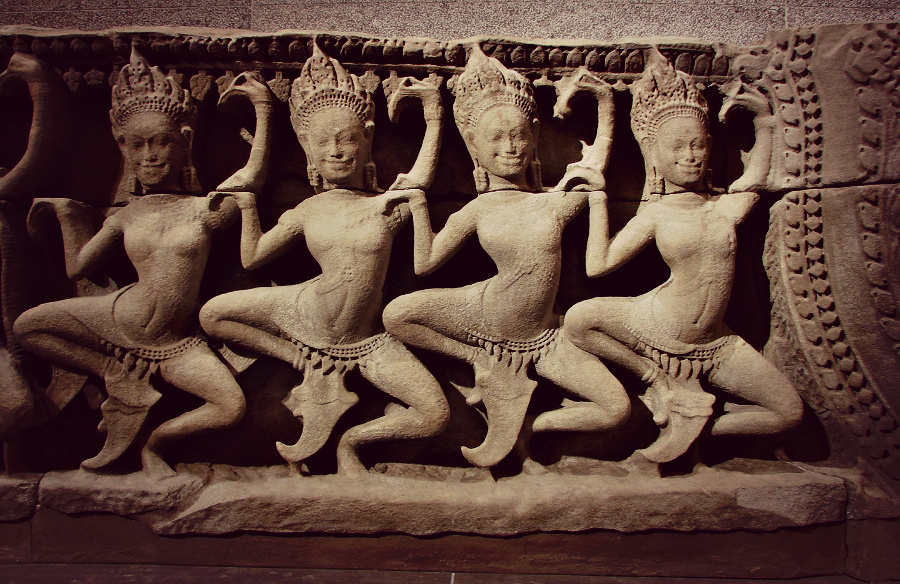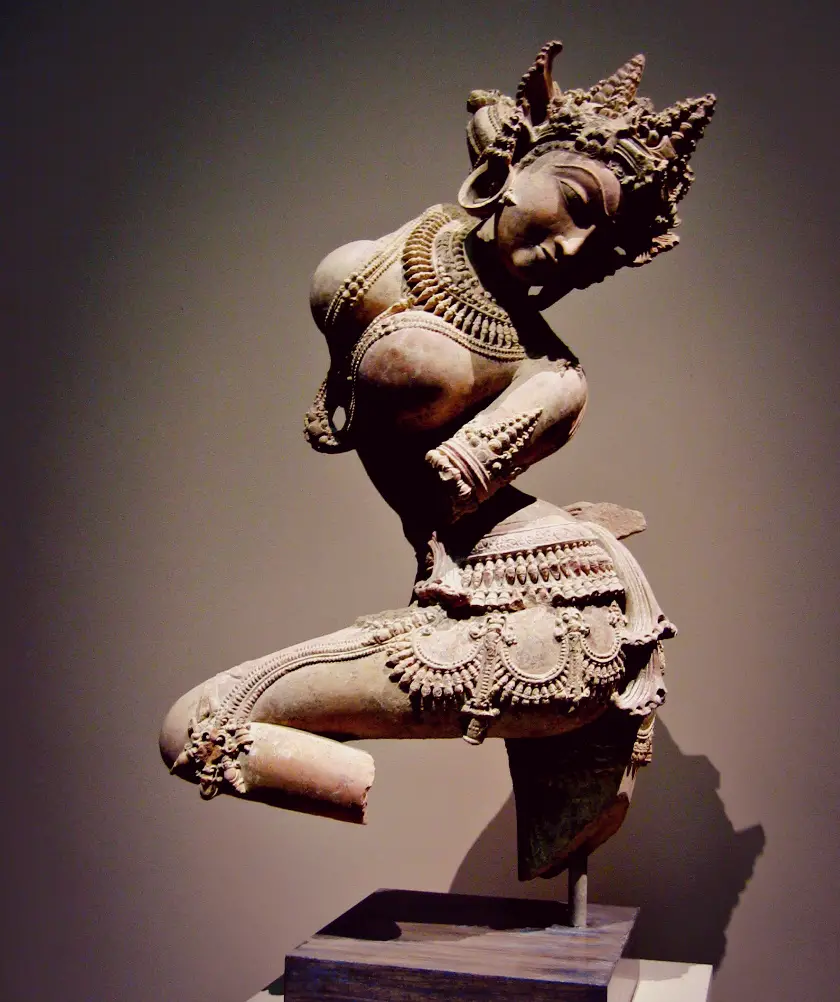A Symbol of beauty, good fortune, fertility, heaven.
Apsaras are feminine shape-shifting spirits of the waters and clouds. They were the first water nymphs that were born in the churning ocean. They are found in Hindu, Buddhist, and Asian mythology. Apsaras are often wedded to Gandharvas, heavenly beings from Hinduism, Buddhism, and Jainism. Apsaras are known to seduce men and gods and dance in the halls of the gods. They were created to pleasure heroes and the gods. Apsaras are linked to good fortune with gaming and gambling. They are also associated with fertility. Some people have compared them to angels from Christianity and muses from Greek mythology.
There are two kinds of apsaras: the worldly, or Laukika, and the divine, or Daivika. There are ten total Daivika and thirty-four Laukika. It is believed that when a warrior dies, an elephant uses his tusks to throw them into the arms of the Apsaras waiting in heaven. Jealous wives of the soldiers have thrown their bodies on their husbands’ funeral pyre to prevent them from meeting the Apsara in heaven. They have been found in many different pieces of literature, including the Rigveda, a Vedic Sanskrit collection of hymns which mentions apsaras, as does the Natya Shastra, a Sanskrit work about the performing arts. The Mahabharata, a Sanskrit epic, also talks about apsaras. Urvashi is one of the divine apsaras that appears in the Rigveda. Her lover was Pururavas, a king of the lunar race. The Rigveda has a hymn dedicated to Urvashi and Pururavas. The Natya Shastra lists many different apsaras.

In the Mahabharata, there are numerous lists of apsaras. Usually, these lists show which apsaras are dancing for the court. Urvashi is mentioned in this text. Urvashi was a dancer in the court where Arjuna, a mortal prince, was visiting his father. Arjuna caught Urvashi’s eye, and she tried to seduce him. Arjuna avoided her seduction, and Urvashi cursed him to be a eunuch for one year. Tilottama was another divine apsaras who was mentioned in the Mahabharata. She saved the world from Upasunda and Sunda, who were brothers. They had almost managed to take over the world when Tiilottama was ordered to cause a rift between them. Tilottama went down to earth and met the two brothers. They both fell instantly in love with Tilottama and ended up killing each other out of love for Tilottama. Another story from the Mahabharata talks about the apsaras Menaka. She was sent to earth by Indra, a guardian deity, who was concerned about Viswamitra, who was an ascetic. Viswamitra was creating great energy in the world by practicing his asceticism. Indra sent Menaka down to distract Viswamitra and save the world. As she was approaching Viswamitra, Vayu, the wind god, blew off her robe. Viswamitra was so overcome by her beauty that they had sex over and over. Because of this coupling, the world was saved.
Apsaras are also found on the stone walls of the Angkorian temples of Cambodia. These temples date back to the 9th century. Apsaras are pictured dancing or ready to dance. These pictures have inspired a dance called the Apsara Dance that the Royal Ballet of Cambodia created in the twentieth century. The dancers narrate religious stories and classical myths with their dance.
In the Malay language, they use the term Bidadari to describe apsaras. They are fairies who have magical powers. These apsaras dance in Indra’s heaven. They are celestial maidens to Indra. Indra would send his apsaras to earth to prevent mortals from becoming too engrossed in religious practices. The Malay traditions influenced Bali, and they have divine maidens in their dances. When Islam was adopted, the apsaras became the houri of Islamic traditions. Houri were the divine maidens of the Islamic culture, and when Bali adopted Islam, the apsaras became holy wives to those who had led a sin-free and holy life on earth.
Temples on the island of Java from the eighth century have depictions of apsaras, as do many Buddhist temples in the area from the ninth century. There are also apsaras in the art of the Indic culture dating back to 500 A.D. Apsaras are also found on frescos from 5th century India and Sri Lanka.

Symbols Menu:
» Amulet
» Ajna
» Arsenic
» Merkaba
» Hung
» Yin Yang
» bindi
» IK Onkar
» Khanda
» Halo
» jiahu
» Tau
» Uraeus
» Menorah
» Quincunx
» Tilaka
» Taijitu
» Vajra
» Chai
» Chi Rho
» Bagua
» Dragon
» Hunab Ku
» Caduceus
» Infinity
» Ichthus
» Hedjet
» Lauburu
» Om
» Ankh
» Chalice
» Pentacle
» Maat
» Ogham
» Mandala
» Kartika
» Khamsa
» Heart
» Labrys
» Sun Face
» Raven
» Triskele
» Scarab
» Dove
» Hanukia
» Anubis
» Trishula
» Durga
» Mezuzah
» Bay Tree
» Geruda
» Kinnara
» Quito
» Condor
» Blue Jay
» Falcon
» Makara
» Rosary
» Uluru
» Apsaras
» Hanuman
» Serpent
» Minotaur
» Mercury
» Apex
» Vestra
» Yoni
» Astarte
» dakini
» Calabash
» Mandrake
» Rebis
» Typhon
» Vegvísir
